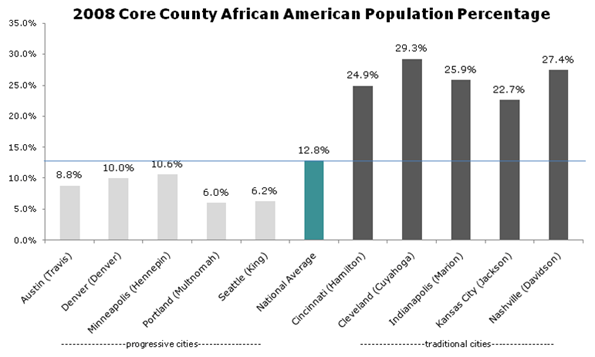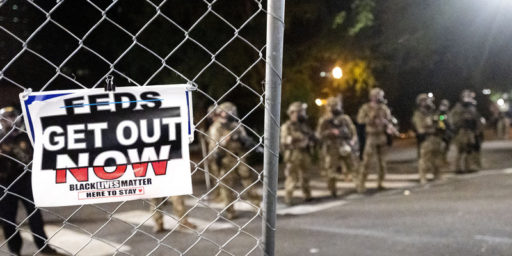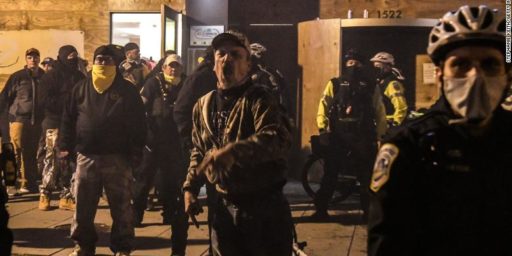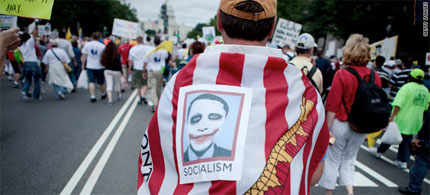White Cities
White elites, shockingly, seem to enjoy cities where the culture is dominated by white elites. Aaron Renn breaks the news.
Among the media, academia and within planning circles, there’s a generally standing answer to the question of what cities are the best, the most progressive and best role models for small and mid-sized cities. The standard list includes Portland, Seattle, Austin, Minneapolis, and Denver. In particular, Portland is held up as a paradigm, with its urban growth boundary, extensive transit system, excellent cycling culture, and a pro-density policy. These cities are frequently contrasted with those of the Rust Belt and South, which are found wanting, often even by locals, as “cool” urban places.
But look closely at these exemplars and a curious fact emerges. If you take away the dominant Tier One cities like New York, Chicago and Los Angeles you will find that the “progressive” cities aren’t red or blue, but another color entirely: white.
In fact, not one of these “progressive” cities even reaches the national average for African American percentage population in its core county. Perhaps not progressiveness but whiteness is the defining characteristic of the group.
He’s even got a handy dandy chart:
Not noted in the article but worth mentioning in this context: The “African Americans” in Minneapolis are mostly Africans, not Americans. There’s a huge Somali refuge population as a function of rather recent public policy decisions.
This raises troubling questions about these cities. Why is it that progressivism in smaller metros is so often associated with low numbers of African Americans? Can you have a progressive city properly so-called with only a disproportionate handful of African Americans in it? In addition, why has no one called these cities on it?
What is it that these cities are supposed to do? Send out advertisements for more blacks to move there?! Our black population is concentrated in the Deep South, for obvious reasons, and in a handful of urban centers that were built around industrial jobs and therefore encouraged a huge migration.
As the college educated flock to these progressive El Dorados, many factors are cited as reasons: transit systems, density, bike lanes, walkable communities, robust art and cultural scenes. But another way to look at it is simply as White Flight writ large. Why move to the suburbs of your stodgy Midwest city to escape African Americans and get criticized for it when you can move to Portland and actually be praised as progressive, urban and hip? Many of the policies of Portland are not that dissimilar from those of upscale suburbs in their effects. Urban growth boundaries and other mechanisms raise land prices and render housing less affordable exactly the same as large lot zoning and building codes that mandate brick and other expensive materials do. They both contribute to reducing housing affordability for historically disadvantaged communities. Just like the most exclusive suburbs.
Now, I live in the Washington, DC area, which is incredibly diverse in terms of both a large black population and a much higher international immigrant population than the national average. I’ve got no dog in this fight. But it strikes me as silly to attribute predominantly racial motivation for moving to these cities. People go there for good jobs and quality of life.
In comparison to the great cities of the Rust Belt, the Northeast, California and Texas, these cities have relatively homogenous populations. Lack of diversity in culture makes it far easier to implement “progressive” policies that cater to populations with similar values; much the same can be seen in such celebrated urban model cultures in the Netherlands and Scandinavia. Their relative wealth also leads to a natural adoption of the default strategy of the upscale suburb: the nicest stuff for the people with the most money. It is much more difficult when you have more racially and economically diverse populations with different needs, interests, and desires to reconcile.
Right. And who wants more difficult problems to reconcile?
Even Matt Yglesias finds this argument “slightly odd.” For one thing, he correctly notes that number of blacks isn’t the only measure of diversity. Austin, for example, is less white than the country as a whole, with the diversity mostly added by Hispanics. And Renn goes to great lengths to dismiss foreign immigrants, which most of these cities have in great abundance, as a proper measure of diversity since they tend to be more affluent than inner city blacks.
But to take what I think is the ray of truth here, if you take a place that’s under-invested for decades in walkable urbanism and then create a bit of walkable urbanism the tendency is for that bit to become very expensive. And since African-American households have lower incomes and substantially less wealth than white households, the tendency is for the walkable urban places to become white. But to raise this as an objection to building walkable urbanism is like saying that we shouldn’t try to have great public schools, because poor people might not be able to afford to live near them. That’s totally backwards—the inability of poor people to afford to live in good school districts highlights the need for more good educational opportunities not fewer. By the same token, if investments in walkable urbanism cause prices to shoot up and price people out of the area that shows that we need more walkable urbanism.
Right. To go further, it’s simply bizarre to criticize people for trying to build desirable communities for themselves simply because some people living elsewhere don’t have it so good.
Beyond that, it’s worth reading recent posts by Andrew Sullivan and others in reaction to Pat Buchanan‘s latest article lamenting the loss of white American culture. The upshot of all of them is that, as Sully puts it, “white Americans do not realize how black they are.” By which he means how much of our culture is impacted by black culture via what we used to call “the melting pot.” See Sully here, here, here, here, here, and here. Also James Poulos. Ann Althouse disagrees slightly.
“Diversity” is something that’s been advanced as a goal in recent years and which has in turn sparked a counter-diversity push by whites, like Buchanan, who see it as a threat. It’s a very odd thing in that there’s never been a more diverse culture anywhere. Not only are we a giant melting pot drawn from all the world’s cultures — even while our common core is Western European — but we’re incredibly heterogeneous. Life varies from city-to-city, state-to-state, and region-to-region. And “diversity” means more than “percentage of poor blacks.”
So, it’s more than slightly odd for someone to argue for more diversity by arguing we ought all be more alike.







Right. I’ve often wished that some president would begin the state of the union address thusly:
“I’ve asked the census bureau to compile a list of countries that has sent its sons and daughters to our shores as immigrants. The list is very long, as you might guess, but I can give you the short version: Every country on earth has done so.”
Now, I don’t know if that is in fact true, but I’d bet it is. We’re not a nation of towns, cities, counties, and states–we’re an idea given substance out of the flesh of the entire world.
Imagine an America without Rock n’ Roll.
Interesting comparisons; What is the tax structure of these “cool” localities? What is the ACTUAL population that is actually paying IN taxes?
What is the ratio of “occupant owned” house/homes/condos to rentals? What is the amount of public assistance for “ownership” verses “rental assistance (Section 8)”
Nearby city to me, historical, lots of industry, one time center of several industries that are gone — too dirty, smelly, insults our sensibilities. So factories and facilities that employed a large number of people are gone. Proof!
Large scale urban decay sets in. Housing is bought up for rentals, but no care is taken in the upkeep, by occupants or owners. Small business leave their historical “downtown” locations.
Taxes go up on whom-ever remains, those that can, leave.
The death of yet another City.
I object to those places being called “progressive”. Progressive has a positive connotation, and I find little about them positive. I have had extended visits to all of the places mentioned except Austin and Minneapolis. Their socialist rules are stifling at best and downright oppressive at worst. Believe me, I prefer the freedom of living where there is a lot less “progressiveness”.
Funny how the inarguably progressive DC is left off the list. I guess we didn’t fit the thesis very well.
I mostly agree with Joyner. You have to look pretty specifically at a handful of cities that fit the thesis. And even cities that do, such as the MSA that I live in, you get the gentrification of whites moving into predominantly black neighborhoods for various reasons.
My current neighborhood is a former crime zone that managed to turn itself around. Ironically, the result is that it’s losing its minority flavor, whites are moving in with increasing frequency, and the minorities that turned the neighborhood around in the first place are (depending on the housing market) likely to be gradually priced out of the neighborhood.
At the same time, however, white progressives are moving to Portland despite the dearth of opportunities and this is an interesting development. And whites in NYC and other multicultural cities tend to live in enclaves populated by other whites. People like to live around people like themselves.
The main use for this information, I think, is to get those that argue that whites fled to the suburbs were not just doing so because they fear minorities. The situation is more complicated than that.
Renn:
Renn needs to consult Stimpy–he’s an idiot.
To claim that the Netherlands, for example, is homogeneous, is just wrong. The country as a whole has 20% non-Dutch–Amsterdam as the major entrance point for immigrants is probably much higher.
Sweden has 18% non-Swedes.
The implementation of specific policies with regard to urban design, housing, culture, etc…. has nothing to do with a perceived demographic homogenization. This homogenization simply doesn’t exist.
This guy needs to get out of his office more.
Triumph, are you good at picking nits? Funny how everyone seems to miss the idea the more liberal the city, the less freedom there is to practice. I live close to the college town of Davis, CA. You cannot smoke a cigarette standing still in that town. No lights can operated at night if the source of the light can be seen from above. They have some many stupid rules in that time one feels oppressed just visiting.
Yeah, right. Go to Indianapolis. The place has been run by so-called Republicans for years and you caint smoke there neither.
Mayor Ballard also wants to impose a radical environmentalist agenda on citizens. He’s got a whole plan to reduce emissions like AlGore.
I contend that there is no such thing as a “non liberal city.” All cities are dominated by libs, which is why we need to remember that REAL America is in places like Wasilla.
If we did away with cities we would be a whole hell of a lot better off. We would be rid of the country’s entire population of fascist, freeloading libs.
Mmmphfff.
Me, too.
Then again, what we’re talking about here, is not race, but culture.
If you think otherwise, I challenge you to look at the reaction of most blacks to any conservative black. notice, please that their anger is not directed so much at the color of the skin or the ethnicity, but the culture the black conservative chooses to embrace.
look at the killings in Chicago recently of straight A students, apparently simply for being straight A students, by people who will be lucky to finish high school, much less keep a job after. And again, the people on both sides of that divide are the same race.
I say again, the issue isn’t rice, its culture.
James, I think you have some interesting points here, but I think you may have missed the larger point of this article because there is some context to the list of cities that he’s using that connects them.
These are the same cities that are held up as exemplars by Richard Florida and some of the consultants who work in this field. The notion is that these cities pull in young “creatives” (as they sometimes call them) that move to these cities without jobs (which is one of the things that is missed in the post and many of the comments) and that these “creatives” will stay and create careers there. Part of their reasoning is that the creatives are attracted by the progressiveness of these cities. But, if it turns out that this set of cities has far fewer African-Americans, then the “progressive” creatives may just be participating in the same kind of white flight as what led to the development of the suburbs, as they are drawn to cities that are less African-American. Or, is it that the policies in question are invested with racism?
I’m not advocating for the Florida thesis, but I want to contextualize the post in a broader way. Like I said, James, your points are well-taken, but there is some unspoken context in this post that indicates that Renn is taking some shots at some of the consultants that I mention above. Renn’s post seems to be focused in a discussion that the urban planning crowd is having amongst themselves.
Why would an African-American be upset with a black conservative for being black?
What are you talking about?
“Progressive has a positive connotation”
Any word can be degraded by it’s association and use. Progressive is just one more word in a long line to be thus corrupted and no longer viewed universally as positive.
People seldom pay attention anymore to traditional definitions, eschewing them in favor of imbuing everything they read with inferred meanings, thereby converting the English language to a sort of “Babel Speak”.
The result is a loss of understanding in the midst of a time that appears to have an endless variety of “modes of communication”.
To quote an illustrious former chief executive, I guess it all…….
“Depends on what your definition of is is.”- Bill Clinton
Much like progressives who send their children to private schools, or who idolize northern Europe, or who vacation in Martha’s Vineyard or who work in all white think tanks or investment banks or universities, progressives talk a good game but make life decisions like a white supremacist.
Look at how Vermont is overrun with white liberals so left NYC. Look at how the whites in DC, NYC, etc concentrate themselves into just a few neighborhoods.
The Washington Post once had an article about interns and fellows in DC. Two of the pictures in the story had a table full of 20 something white women in a northwest DC bar and a table with all blacks in a U Street restaurant.
What progressives really remind me of are the whites in the rural south. They find ways to exist while avoiding blacks as much as possible.
So I guess non-rural whites in the South don’t do that? Or even non-progressive whites?
I just wanted to pop in and say that Seattle is such a wonderful, colorblind utopia that I don’t even notice that there are no black people.
But, I think that Aaron Renn is guilty of cherry picking cities to meet his hypothesis.
I grew up in Portland, and live in Seattle now. I think what’s missing in Renn’s analysis is the fact of deep cultural change. Sure, Portland is now a progressive city, with overall open attitudes held by most of the people who live there. But it has not always been that way. In the first half of the last century, Portland had the reputation of being the “most prejudiced city in the West” when it came to blacks.
This article talks about the Vanport Flood, in which a flood destroyed the black-dominated public housing project and blacks basically were turned out of town. There’s also a question of whether city officials knew the flood was going to happen and failed to let any of Vanport’s (black) residents know about it.
So what we have, IMHO, is Portland as a city whose racist attitudes have likely significantly factored into its demographics. The only problem with “calling them out” on it is that the racist attitudes are gone with the people who held them. If you want to call a geographical place out for views next to nobody still has in it, go ahead, but the “what are they supposed to do about it?” question still doesn’t have an answer.
Percentage of African Americans is a pretty arbitrary criterion for assessing a city’s homogeneity. I live in Minneapolis, which is indeed a pretty white city. However, there has been a huge influx of Somali, Hmong and Hispanic immigrants. Drive down Lake Street in South Minneapolis, and you might think you’re in Texas with all the Mexican restaurants and billboards in Spanish. Go the the West Bank area by the University of Minnesota and see why some call it Little Mogadishu. The light rail system has instructions in English, Spanish, Somali, and Hmong. The main reason there is a smaller African American population here is there was less heavy industry. When African Americans migrated north there were fewer jobs available for them here.
Regarding your facts on Hennepin County’s (Minneapolis) African American population. You state that, “[t]he “African Americans†in Minneapolis are mostly Africans, not Americans.”
Census figures show African American population in Hennepin County to be approximately 121,000. The estimated Somali population for the entire state of Minnesota is 35,000 to 40,000.
So, the great majority of African Americans in Hennepin County are in fact American born, as opposed to recent African immigrants.
The article was all kinds of fail. He skips over comparable cities like Columbus Ohio. I don’t think the author has been to Indianapolis lately, that place has done a 180 in the last 10 years.
I’m sure the author doesn’t know about Cincy’s almost completed subway system (and why it was never used) or Cleveland’s subway system (that no longer insists). In fact in Cleveland the East side (where most of the blacks and Jews live) has better public transportation than the west side.
Cleveland, (like a lot of older cities) once was very ethnically segregated (look up Kucinich’s run for mayor against Voinovich).
He skips over history, like the once very active KKK in Oregon, he skips over state demographics, and also the numbers of people marking more than one race (which was something you could not do in this country for a long time).
Also, what makes a city progressive? I lived in Austin (and have lots of family there) we moved to Dallas not because it had more black folks, but because my dad’s job moved him there. Again on a historical note, the author failed to compare current percentages of blacks in those “progressive” cities with historical numbers (look at Columbus Ohio for example).
Again the reason Cleveland doesn’t have a good transportation system (besides the fact that Kucinich refused federal funds to build one in the 70’s) has nothing to do with blacks not wanting a better system, as much as the west-side of the city no really wanting to be connected, and also how city contracts are corrupt.
Lastly, last time I checked Indianapolis has a growing population (that included many middle class Latinos), Columbus has a growing population (that includes many high income blacks, and foreign born populations), and Minneapolis had a large immigrant population.
I think what pissed me off the most was the sense that this author had not really visited a lot of the cities he talked about.
William d’Inger: You must be a blast at parties.
As for the Aaron Renn post: Most of these cities have large minority populations even if they don’t have large black populations. I’ve only spent a little time in Portland, so I can’t comment, but I’ve lived in or visited for extended periods all of the other cities, and they aren’t white enclaves by any means.